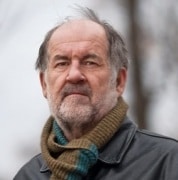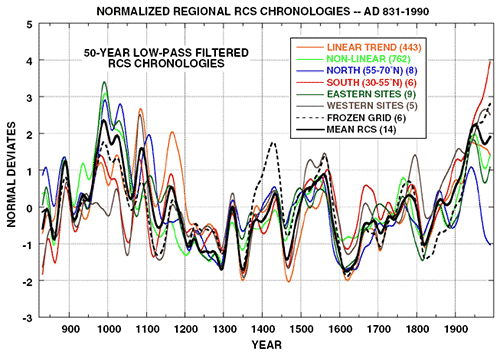[Update June 17th] Scholars & Rogues sparked a vigorous discussion about various tree-ring chronologies, and readers are encouraged to look through the discussions on S&R as well as McIntyre’s Climate Audit for all the juicy details. We also wish to note a correction made by Angliss regarding which graph was in discussion, but that point was not quoted by Desmogblog here.
Finally, we wish to highlight Desmogblog’s interest in the subject. We distinguished below between “the new famous ‘hide the decline’ statement, which Fox News picked up as meaning ‘hide the decline in all global temperatures’,” vs. the more subtle discussion points of specific pieces of climate evidence.
Last week we mentioned a detailed analysis by Scholars & Rogues about how the stolen emails lack enough context to draw conclusions about climate science. This week in part 2, Brian Angliss gets more into the nitty-gritty details, challenging statements made by self-appointed Climate Auditor and mining executive Steve McIntyre and others.
Often McIntyre’s discussions are not commented on by climate scientists, because they aren’t worth replying to. RealClimate.org does when a response is warranted, but most claims and assertions go unchecked, becoming memes within a small subsection of passionate climate scpetics. Angliss has found numerous misrepresentations within McIntyre’s writing, calling him out on exactly the kind of thing he likes to accuse real climate scientists of.
For example, Angliss gets into the weeds on the new famous ‘hide the decline’ statement, which Fox News picked up as meaning ‘hide the decline in all global temperatures’. McIntyre and others are more restrained, focusing on the decline shown by tree ring data, which is one form of climate change evidence. Yet the set of tree ring data they come back to time and again, the Briffa reconstruction, is only a small part of the evidence we have.
First, the tree rings that diverge from the instrumental record are not all tree ring datasets, but rather a subset of tree ring datasets. In particular, the divergence problem applies to the Briffa 2000 dataset taken from trees close to the Arctic Circle. Other tree ring datasets don’t show the same divergence issue, as summarized in Cook et al 2004 and as shown in the image below (note that the northern tree rings in dark blue diverge while the southern tree rings in red do not – and Briffa’s rings are from northerly trees). In summary, the southerly tree ring record matches the instrumental record while the northerly tree rings diverge after 1950 or so.
While this graph is only partially relevant to the exact discussion of a specific graph discussed in the emails, it is helpful to put the entirety of this episode into context, which is exactly what Angliss is doing. He then gets more specific in terms of addressing McIntyre’s concern.
Second, recent papers have shown that, before the period of divergence, reconstructed temperatures from northerly tree rings closely match may other temperature proxies including boreholes, corals, lake sediments, stalagmites, and the lengths of glacial tongues. As John Cook, editor of the climate science website Skeptical Science put it,
Since 1999, there have been many independent reconstructions of past temperatures, using a variety of proxy data and a number of different methodologies. All find the same result – that the last few decades are the hottest in the last 500 to 2000 years (depending on how far back the reconstruction goes). (source)
While the Cook et al 2004 paper was not published until after the TAR, Fuller’s and McIntyre’s claims of replacement and substitution were published in January and March, 2010 respectively. At this point, McIntyre and Fuller should both be aware enough of the progress made in dendroclimatology (deducing past climate from tree rings) since 2001 to not make erroneous claims.
You’re forgiven if this seems dry and tedious, because it can be, and a big thanks is owed to Scholars & Rogues for the detailed analysis. Check out the entire piece for more depth.
DeSmogBlog seeks to uncover the spin and propoganda that dirty energy interests masquerade as expert opinion in the theatre of politics. We seek to clear the air and help show readers the bigger picture. We happily let others deal with the nuances of temperature records or the exact meaning of emails stolen from East Anglia climate researchers. Why? Because independent reviews, scientists and even the authors of the book Climategate: The CRUtape Letters (who helped break the story in the first place) agree that these minor discussions don’t change the overall understanding of climate change.
Subscribe to our newsletter
Stay up to date with DeSmog news and alerts






